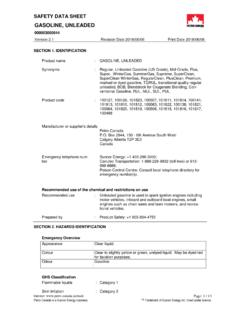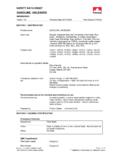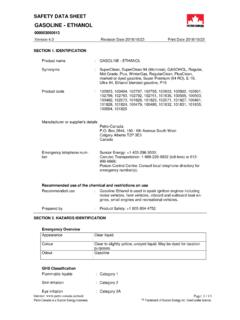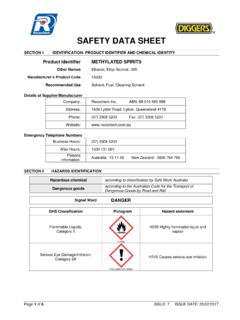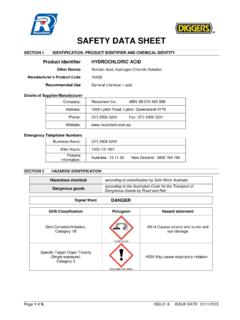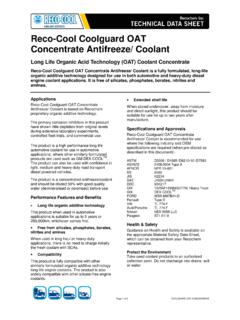Transcription of Universal Antifreeze/Coolant - Petro-Canada
1 safety data sheet Universal Antifreeze/Coolant SECTION 1. IDENTIFICATION. Product Identifier Universal Antifreeze/Coolant Other Means of 16-242, 16-244, 16-245, 26-248, 26-248-1000, 26-248PC, 35-249FS, 36-241SO, Identification 36-244 APREXP, 36-244AX, 36-244 AXEXP, 36-244C, 36-244 CHR, 36-244CQ, 36-244E, 36-244 FEDEXP, 36-244FS, 36-244PC, 36-244PM, 36-244 PMEXP, 36-244 PPEXP, 36-244 PROFEXP, 36-244 RAD, 36-244SO, 36-244SP, 36-244 SPROEXP, 36-244 STP, 36-244 STPEXP, 36-244TH, 36-244 TOT, 36-244U/N, 36-244 UFA, 36-244UG, 36-245 UFA, 36-249 AXEXP, 36-249 CHR, 36-249E, 36-249 SPROEXP, 36-254SO, 86-244-PRO, 86-244SY, 86-249, 86-249-1000, BULK-16245, BULK-86245, BULK-TRUCK26429. Recommended Use Please refer to Product label. Restrictions on Use None known. Manufacturer / Recochem Inc., 850 Montee de Liesse, Montreal, QC, H4T 1P4, Compliance and Regulatory Supplier Department, 905-878-5544, Emergency Phone No. CANUTEC, 613-996-6666, 24 Hours SDS No.
2 1552. SECTION 2. HAZARDS IDENTIFICATION. GHS Classification Acute toxicity (Oral) - Category 4; Reproductive Toxicity - Category 1B; Specific target organ toxicity (repeated exposure) - Category 2. GHS Label Elements Signal Word: Danger Hazard Statement(s): H302 Harmful if swallowed. H360 May damage fertility or the unborn child. H373 May cause damage to organs (kidneys) through prolonged or repeated exposure following skin contact and/or if swallowed. Prevention: P201 Obtain special instructions before use. P202 Do not handle until all safety precautions have been read and understood. P260 Do not breathe fume, mist, vapours, spray. P264 Wash hands and skin thoroughly after handling. P270 Do not eat, drink or smoke when using this product. P280 Wear protective gloves/protective clothing/eye protection/face protection. Response: Product Identifier: Universal Antifreeze/Coolant P301 + P312 IF SWALLOWED: Call a POISON CENTRE/doctor if you feel unwell.
3 SDS No.: 1552 Page 01 of 08. P330 Rinse mouth. Date P308of+Preparation: P313 October IF exposed 01, 2015 Get medical advice/attention. or concerned: P314 Get medical advice/attention if you feel unwell. Storage: Response: P301 + P312 IF SWALLOWED: Call a POISON CENTRE/doctor if you feel unwell. P330 Rinse mouth. P308 + P313 IF exposed or concerned: Get medical advice/attention. P314 Get medical advice/attention if you feel unwell. Storage: Store in a well ventilated place. Keep cool. Keep container tightly closed. Store locked up. Disposal: Dispose of contents/container in accordance with applicable regional, national and local laws and regulations. Note: % of the mixture consists of ingredient(s) of unknown acute toxicity. Other Hazards None known. SECTION 3. COMPOSITION/INFORMATION ON INGREDIENTS. Mixture: Chemical Name CAS No. % Other Identifiers Ethylene glycol 107-21-1 60-100. Sodium Salt of Boron Acid CBI*. Notes The specific chemical identity and/or exact percentage of composition (concentration) has been withheld as a trade secret.
4 SECTION 4. FIRST-AID MEASURES. First-aid Measures Inhalation Remove source of exposure or move to fresh air. Call a Poison Centre or doctor if you feel unwell or are concerned. Skin Contact Take off contaminated clothing, shoes and leather goods ( watchbands, belts). Wash gently and thoroughly with lukewarm, gently flowing water and mild soap for 5 minutes. Call a Poison Centre or doctor if you feel unwell or are concerned. Clean clothing, shoes and leather goods. Eye Contact If eye irritation persists, get medical advice/attention. Immediately rinse the contaminated eye(s) with lukewarm, gently flowing water for 15-20 minutes, while holding the eyelid(s) open. Ingestion Rinse mouth with water. Call a Poison Centre or doctor if you feel unwell or are concerned. Most Important Symptoms and Effects, Acute and Delayed If swallowed: There are 3 stages of effects, which can overlap. Early symptoms can include upset stomach, slurred speech, clumsiness, drowsiness, and convulsions.
5 Second stage symptoms can include rapid heartbeat and breathing, bluish lips and skin, fluid in the lungs and heart failure. In the last stage, there can be kidney stones and kidney damage with lower back pain, and increased then decreased urine production. There may be delayed nervous system effects such as paralysis of the face, clumsiness, impaired hearing and blurred vision. Death can occur at any stage. Immediate Medical Attention and Special Treatment Product Identifier: Universal Antifreeze/Coolant SDS No.: 1552 Page 02 of 08. Date of Preparation: October 01, 2015. Immediate Medical Attention and Special Treatment Target Organs Digestive system, nervous system, heart, digestive system, kidneys, skin. Special Instructions The signs and symptoms in ethylene glycol poisoning are those of metabolic acidosis, central nervous system depression and kidney injury. Clinical chemistry may reveal anion-gap metabolic acidosis and uremia. Treatment with ethanol to inhibit the metabolism of glycol to administration of ethanol may counter the toxic effects of ethylene glycol (cardiopulmonary effects attributed to metabolic acidosis and renal damage).
6 Hemodialysis or peritoneal dialysis have been of benefit. Pre-existing respiratory and skin disorders may be aggravated by over-exposure to this product. Treat symptomatically and supportively. Medical Conditions Aggravated by Exposure Dermatitis. SECTION 5. FIRE-FIGHTING MEASURES. Extinguishing Media Suitable Extinguishing Media Carbon dioxide, dry chemical powder or appropriate foam. Unsuitable Extinguishing Media None known. Specific Hazards Arising from the Chemical Can ignite if strongly heated. In a fire, the following hazardous materials may be generated: irritating chemicals. Special Protective Equipment and Precautions for Fire-fighters Review Section 6 (Accidental Release Measures) for important information on responding to leaks/spills. See Skin Protection in Section 8 (Exposure Controls/Personal Protection) for advice on suitable chemical protective materials. SECTION 6. ACCIDENTAL RELEASE MEASURES. Personal Precautions, Protective Equipment, and Emergency Procedures Use the personal protective equipment recommended in Section 8 of this safety data sheet .
7 Environmental Precautions Do not allow into any sewer, on the ground or into any waterway. Methods and Materials for Containment and Cleaning Up Stop leak if without risk. Move containers from spill area. Approach release from upwind. Prevent entry into sewers, water courses, basements or confined areas. Wash spillages into an effluent treatment plant or proceed as follows. Contain and collect spillage with non-combustible, absorbent material sand, earth, vermiculite or diatomaceous earth and place in container for disposal according to local regulations (see section 13). Use spark-proof tools and explosion-proof equipment. Dispose of via a licensed waste disposal contractor. Contaminated absorbent material may pose the same hazard as the spilled product. Note: see section 1 for emergency contact information and section 13 for waste disposal. SECTION 7. HANDLING AND STORAGE. Precautions for Safe Handling Put on appropriate personal protective equipment (see section 8).
8 Eating, drinking and smoking should be prohibited in areas where this material is handled, stored and processed. Workers should wash hands and face before eating, drinking and smoking. Do not ingest. Avoid contact with eyes, skin and clothing. Avoid breathing vapour or mist. Use only with adequate ventilation. Wear appropriate respirator when ventilation is inadequate. Do not enter storage areas and confined spaces unless adequately ventilated. Keep in the original container or an approved alternative made from a compatible material, kept tightly closed when not in use. Store and use away from heat, sparks, open flame or any other ignition source. Use explosion-proof electrical (ventilating, lighting and material handling) equipment. Use non-sparking Product tools. Take precautionary Identifier: measures against electrostatic discharges. To avoid fire or explosion, dissipate Universal Antifreeze/Coolant static electricity SDS No.: during transfer 1552 by grounding and bonding containers and equipment before transferringPagematerial.
9 Empty 03 of 08. containers retain product residue and can be hazardous. Do not reuse container. Date of Preparation: October 01, 2015. other ignition source. Use explosion-proof electrical (ventilating, lighting and material handling) equipment. Use non-sparking tools. Take precautionary measures against electrostatic discharges. To avoid fire or explosion, dissipate static electricity during transfer by grounding and bonding containers and equipment before transferring material. Empty containers retain product residue and can be hazardous. Do not reuse container. Conditions for Safe Storage Store in accordance with local regulations. Store in a segregated and approved area. Store in original container protected from direct sunlight in a dry, cool and well-ventilated area, away from incompatible materials (see section 10). and food and drink. Eliminate all ignition sources. Separate from oxidizing materials. Keep container tightly closed and sealed until ready for use.
10 Containers that have been opened must be carefully resealed and kept upright to prevent leakage. Do not store in unlabeled containers. Use appropriate containment to avoid environmental contamination. SECTION 8. EXPOSURE CONTROLS/PERSONAL PROTECTION. Control Parameters ACGIH TLV OSHA PEL AIHA WEEL. Chemical Name TWA STEL TWA Ceiling 8-hr TWA TWA. Ethylene glycol 10 mg/m3 100 mg/m3 Not 50 ppm established Sodium Salt of Boron Acid Not Not Not Not established established established established Appropriate Engineering Controls The hazard potential of this product is relatively low. General ventilation is usually adequate. Use local exhaust ventilation, if general ventilation is not adequate to control amount in the air. Individual Protection Measures Eye/Face Protection Not required but it is good practice to wear safety glasses or chemical safety goggles. Skin Protection Wear chemical protective clothing gloves, aprons, boots. Nitrile rubber.
